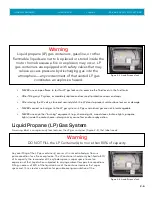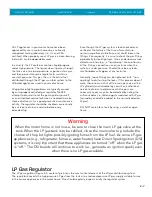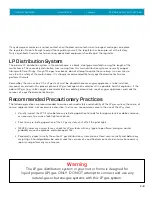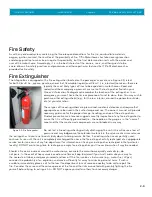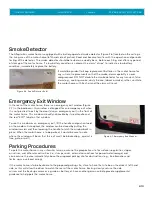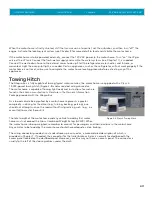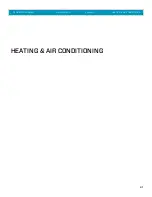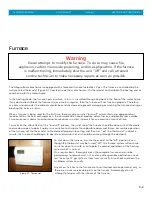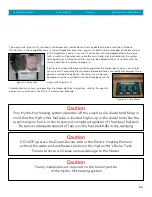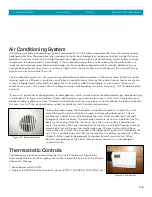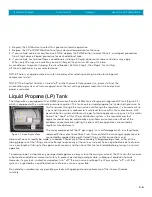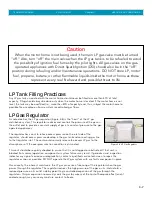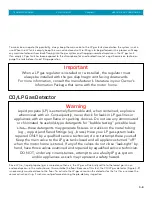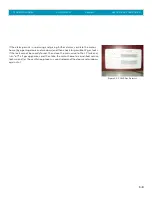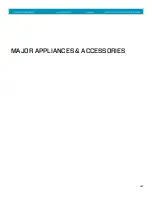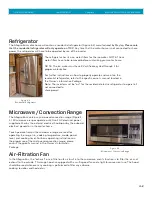
TIFFIN MOTORHOMES
–ALLEGRO BUS®
Chapter 2
DRIVING & SAFETY INSTRUCTIONS
2-7
LP Gas Regulator
The LP gas regulator (Figure 2-4, center of picture) is the most critical element of the LP-gas distribution system.
The regulator converts the high-pressure LP gas from the tank into a reduced-pressure LP-gas supply suitable for use
in the various appliances in the motor home. One should regularly inspect visually the regulator system.
Warning
When the motor home is not in use, be sure to close the main LP gas valve at the
tank. When the LP gas tank is to be refilled, close the main valve to preclude the
chance of the pilot lights possibly igniting fumes from the LP fuel. As some LP-gas
appliances (e.g., refrigerator, furnace, water heater) have Direct Spark Ignition (DSI)
systems, it is very important that these appliances be turned “off” when the LP gas
is “off.” The DSI boards will continue to work (i.e., generate an ignition spark) even
when there is no LP gas available.
All LP appliances in your motor home have been
approved for use in motor homes by a nationally
recognized testing laboratory (i.e., UL and CSA
certified). When properly used, LP gas is a clean-burning
fuel which can be dependably used.
In actuality, the LP container contains liquid propane
under high pressure. The liquid, when it passes through
the tank valve to a lower pressure, vaporizes into a gas,
and then passes through a regulator to maintain a
constant pressure. This gas, then, is the actual fuel
distributed through the LP-gas manifold system to the
LP-based appliances used in your motor home.
LP-appliance-lighting problems are typically caused
by an improperly adjusted gas regulator. NEVER
attempt to adjust or reset the gas regulator yourself,
as an authorized service technician is needed to make
these adjustments. As a good preventive-maintenance
activity, the regulator should be checked semi-annually
by a service technician and also before every
extended trip.
Even though the LP-gas system is leak-checked and
verified at the factory at the time of manufacture,
normal usage (travel vibrations, etc.) could loosen the
fittings. Consequently, it is wise to check the gas fittings
periodically for leak tightness. One can daub some leak-
detector solution (e.g., a “liquid-soap”-like solution) on
all the fittings, connections, and junctures when the
system is under pressure. Should there be any leaks,
small bubbles will appear at any leak sites.
Generally, loose fittings can be tightened (with “non-
sparking” tools) to stop the leaks. If this process doesn’t
work, then one must shut off the main gas valve at the
LP cylinder(s) and immediately consult an authorized
service technician to determine what repairs are
necessary. Leaks may also be detected by noting the
sulfurous odor (i.e., rotten eggs) associated with LP gas
[caused by an additive added to the normally odorless
LP gas].
DO NOT search for a leak by using a match or open
flame.
Summary of Contents for 2014 Allegro Bus
Page 6: ... TIFFIN MOTORHOMES ALLEGRO BUS Chapter 1 GENERAL INFORMATION GENERAL INFORMATION 1 1 ...
Page 51: ... TIFFIN MOTORHOMES ALLEGRO BUS Chapter 5 CABINETS FURNITURE CABINETS FURNITURE 5 1 ...
Page 55: ... TIFFIN MOTORHOMES ALLEGRO BUS Chapter 6 STRUCTURAL FEATURES STRUCTURAL FEATURES 6 1 ...
Page 57: ... TIFFIN MOTORHOMES ALLEGRO BUS Chapter 7 ELECTRICAL FEATURES ELECTRICAL FEATURES 7 1 ...
Page 72: ... TIFFIN MOTORHOMES ALLEGRO BUS Chapter 8 SLIDE OUT FEATURES SLIDE OUT FEATURES 8 1 ...
Page 76: ... TIFFIN MOTORHOMES ALLEGRO BUS Chapter 9 EXTERIOR FEATURES EXTERIOR FEATURES 9 1 ...
Page 83: ... TIFFIN MOTORHOMES ALLEGRO BUS Chapter 10 INTERIOR FEATURES INTERIOR FEATURES 10 1 ...
Page 87: ... TIFFIN MOTORHOMES ALLEGRO BUS Chapter 11 PLUMBING BATH FIXTURES PLUMBING BATH FIXTURES 11 1 ...
Page 105: ... TIFFIN MOTORHOMES ALLEGRO BUS Chapter 13 ROUTINE MAINTENANCE ROUTINE MAINTENANCE 13 1 ...














